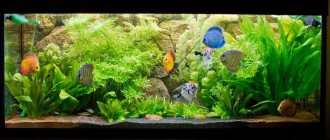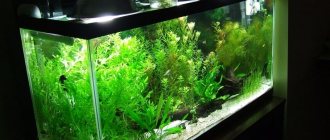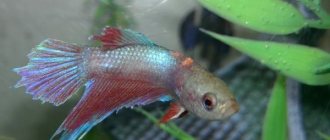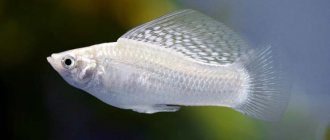GD Star Rating loading…
The modern market for filter materials is so diverse and huge that even managers of large stores sometimes find it difficult to give any recommendations on the choice of a particular filler, and when it comes to planning the systematic use of filter materials in an aquarium, they do not want to delve into the situation at all, and As a rule, they recommend a “standard soup set” of those components that are popular with most aquarists. At the same time, most filter materials in certain situations work much more efficiently if you know their properties and are able to combine filter elements in the order in which they would bring maximum benefit and maximum filter performance.
Depending on how correctly this balance of filter materials is made, the operation of the entire filter will be positive, and as a result, the aquarium inhabitants will feel just as favorable. Therefore, below we will consider a number of basic filter materials, what they are needed for, in the article about external filters you can find out how to correctly arrange these materials, and how they work in the filter and what role they play in the life of the aquarium.
Foam rubber and synthetic filter elements
Today, it is the most affordable filler. Given the low cost of this material, it occupies a leading position in the popularity of its use in filters. Foam rubber and synthetic padding are such easy-to-process materials that you can use them to make almost any shape of filler. Some aquarists use only foam rubber and padding polyester fillers in external filters, when the aquarium is not very busy with inhabitants. In principle, in this case, the filter works as a mechanical water purification filter. As well as a biological filter.
The pores of foam rubber create a sufficient area for colonization of bacteria, which, with a low biological load, fully cope with their functions. From time to time, the foam rubber still needs to be washed, as it begins to become clogged with mucus, as a result of which the necessary bacteria die out.
The pores also serve to retain pieces of silt and other mechanical suspension, which the filter sucks from the water column. The fact is that sludge should not penetrate other elements of the filter as it will clog the porous surfaces of other filter materials, which will significantly reduce the performance of the filter. It should be noted that the filter uses pore sponges, which vary in size and are capable of filtering from the largest particles to the smallest; the last stage of treating water from mechanical suspension is carried out using synthetic padding filler. Beginner aquarists very often make the mistake of buying foam rubber filter elements not in special aquarium stores, but using foam rubber, which is used to make furniture or is used as sponges or washcloths in households. application. This is not acceptable, since this is a completely different foam rubber, which has a completely different structure and can release toxic compounds into the water.
Benefits of Activated Carbon
Aquarists use activated carbon for a variety of benefits. These include:
- water purification from food additives and antibiotic residues;
- cleaning aquarium walls from yellowing;
- elimination of unpleasant odors;
- improving the quality of aquarium water.
Activated carbon
Note! After installing activated carbon in the filter, unpleasant odors in aquarium water disappear almost immediately.
TOP 11 unpretentious aquarium fish TOP 10 largest aquarium fish TOP 20 beautiful aquarium fish TOP 12 most expensive aquarium fish
Filter wool
A wonderful filler for the beginning aquarist. This is a fairly inexpensive reusable filler; you just need to rinse the cotton wool in water and it is ready for use again. The cotton wool can be placed quite tightly, filling the entire provided volume, minimizing leakage of water and silt onto other filter fillers. Recommended for use as the final stage in mechanical water purification. However, we should not forget that cotton wool clogs just as quickly, and therefore this increases the need to constantly care for this filter material, and by constantly opening the filter, you disrupt the work of bacteria that colonize in the filter materials.
Possibility of recovery
Sometimes information comes out that aquarium coal can be restored. Some “Kulibins” are trying to do this. But, before you start using chemicals, it’s worth remembering how coal is made. To restore it, you will need the same process as during manufacture: heating to 1000 degrees without air access. It’s unlikely that anyone will have the necessary equipment. But you can “revive” it a little. This procedure is possible provided that the adsorbent has been used little. In this case, it is washed in ordinary water and heated in an ordinary oven. In this case, the organic matter is partially removed, and not all of the pores are opened. In fact, the manipulation is useless and its benefits are questionable. It's easier to buy a new one. Whatever one may say, “the game is not worth the candle,” and it is better to find another, more useful use for finances.
Plastic balls. (or bioballs)
They are excised plastic balls. From this structure, the balls roll along the streams of water entering the filter and break up the streams, allowing other filter materials to be washed more evenly. Due to their surface, the balls also serve as an excellent substrate for the settlement of beneficial bacteria. But due to the fact that their area is significantly smaller, their effectiveness in terms of a biological filter is extremely low. The cost of such a filler is quite high, so it can be recommended as a filler for biological types of filters such as SAMP.
Top 10 best fillers for external and internal filters
Activated carbon
Outwardly it looks like black granules. It has high absorbency, working like a sponge, removing chemical staining from liquids. Does not react with foreign substances (preparations for fish, snails or algae).
However, it cannot be used as a means of permanent use. The fact is that, having been saturated to the limit with excess organic matter, the coal begins to gradually release all the accumulated substances back into the water, and this has a detrimental effect on the inhabitants of the aquarium. Another disadvantage: it does not filter out ammonia and absorbs microelements necessary for plant growth.
The substance is best used in conjunction with other filter material and in cases where the water is very polluted (or the fish were treated with special preparations in the container). Optimal portion: 50 g of coal per 50 liters of water. The allowed period is no more than two weeks.
The average cost of 500 ml of coal is from 200 rubles, cartridges are from 400 rubles per package (for 500 liters).
Ceramics
This type is made in the form of tubes, hollow inside and small in size.
Due to its porous structure, this filtrate provokes the development of a large number of nitrifying bacteria necessary for a complete nitrogen cycle in the aquarium and the establishment of biological balance. It has a number of advantages:
- due to the holes, water flows are more evenly distributed throughout the entire volume of the container;
- there is no need to wash it, just rinse it in water from the aquarium from time to time;
- affordable.
Popular ceramic fillers include products from Tetra (Germany) and Hydor (Italy). Price range: a package weighing 170 grams costs from 340 rubles in St. Petersburg and Moscow.
Sintepon
The material from which this type of filler is made is very dense and has a special structure. Due to this, the filtration is of very high quality: the synthetic winterizer traps the smallest suspended particles, turbidity and dust that rises after weeding and siphoning the aquarium soil.
The only but significant drawback is that it gets clogged very quickly. After just a week or two, it becomes clogged with filtered particles, turning the material into a dirty and sticky lump. You can try to use it again by rinsing it with running water, but this method can hardly be called practical.
It is a mandatory component of multi-stage filters with high-performance pumps, which are used only in cases of extreme necessity (when you need to quickly remove a huge volume of mechanical suspension from a large-volume container).
The cost of a synthetic padding liner in Moscow and St. Petersburg starts from 176 rubles per set (2 pieces per package). But you can also buy regular padding polyester at a sewing store, which will be even cheaper.
Zeolite
Inexpensive and very effective natural remedy of sedimentary-volcanic origin. Quickly absorbs ammonium, ammonia and other toxic compounds dissolved in water. Cleans liquid from dyes, medications, heavy metals. Acts as a regulator of nutrients and soil batteries in the aquarium.
The disadvantage of long-term use of zeolite is its ability to acidify water over time, reducing the level of phosphates and lowering the acid-base balance.
Reference! Common forms of zeolites are chabazite, clinoptilolite, laumontite, thomsonite, mordenite, heulandite, stilbite, chabazite.
For 1 liter of water, 1 gram of the substance is enough. Requires replacement after 1 - 1.5 months. The sample is a Hydor product. Price per package (640 g) – 617 rubles and above.
Peat
One of the most accessible and cheapest filter media, used for a long time.
It is a collection of partially rotted fossil materials of organic origin. This is a real storehouse of humic acids, organic matter, tannins (tannins), wax, resins, salt and other components. Its advantages:
- prevents the active growth of bacteria and fungi;
- promotes the growth of aquatic plants (especially their roots);
- reduces water hardness;
- lowers and stabilizes the pH value in the slightly acidic region.
However, this substance also has its own characteristics. It cannot be poured directly into the filter, like activated carbon, for example. You should first find out the parameters of aquarium water, since it is prohibited to use it at low levels of hardness and acidity.
If the inhabitants of a home pond are sick with a disease such as alkalosis (alkaline disease), the use of peat should also be abandoned. And one more aesthetic point - peat slightly colors the water, giving it a tea tint. Not everyone likes this.
For the filter, the proportions are 1 liter of peat volume per 100 liters of water in the container. It is necessary to ensure that the material is compacted moderately: being too loosened, it increases the flow of liquid, and it does not have time to be enriched with useful substances, and strong compaction serves as an obstacle to water flow. The mixture must be changed every 3-6 months.
The most popular fillers are JBL Tormec activ and Sera super peat. They consist of two-component peat with varying levels of acidity to gradually soften aquarium water.
Expanded clay
Another type of biological filter is expanded clay. These elongated or spherical elements can be purchased at any construction market or assembled in nature.
Important! Expanded clay collected from nature must be treated before use, as it may contain phosphates, silicates and heavy metals.
- Rinse in a sieve until clear water comes out.
- Boil for 15-20 minutes.
- Spread in a thin layer on a baking sheet and bake in the oven at 180 degrees.
The porous surface of the filler is happily colonized by various bacteria necessary for the nitrogen cycle. This filter material has excellent biological filtration ability and retains large particles of dirt and debris. A package of 1 kilogram costs 50-60 rubles.
Sponge
Not a single filter is complete without a sponge. You should choose a material with a higher structure - it better retains mechanical mixtures.
The price for a package of TetraTec BF 1200 (2 sponges) is 350-400 rubles.
For aquarium needs, a specially designed sponge is used. The material used in the production of toys and furniture is not suitable. Suitable for both external and internal filter types.
Sintered glass
The glass is baked using a certain technology, resulting in a porous material with favorable conditions for the colonization of bacteria. The shape can be different, but balls measuring from 8 to 14 mm are considered more effective. This filter material processes nitrates well and ensures the breakdown of ammonium and nitrites.
The balls should be washed periodically with running water. After 6 months of use, half of the filler must be replaced with a new one.
In terms of available area for bacterial settlement, it surpasses even ceramic rings, but the price is also high: for a package of 650 g (JBL MicroMec) - 971 rubles.
Bioballs
Externally they look like plastic balls with a cut surface. Thanks to this structure, the balls roll along the streams of water poured into the filter and break them up, allowing other filter materials to be washed more evenly.
Experienced aquarists advise using bioballs as an additional filler to filters of a certain type (for example, SAMP), because, despite the surface convenient for bacteria to settle, the efficiency is generally extremely low.
Tetra BB 800 ml pack. costs 389 rubles.
Gravel
The surface area of gravel is comparable to the area of expanded clay, but, unlike the latter, the angular shape of gravel is well suited as a filtrate for mechanical construction. Biological filters not equipped with backwash systems require gravel of the same size.
The cost of a 25 kg bag starts from 300 rubles, but you can prepare it completely free of charge, which is an additional advantage.
Requires washing and baking in the oven before use.
Sintered glass
To fill the filters, various forms of sintered glass substrate are used, these can be either tubes or balls. The most effective is the use of balls measuring from 8 to 14 mm. The fact is that, thanks to a special manufacturing process, the glass is baked at a certain temperature. This technology makes it possible to create a porous material that, when used, becomes colonized with bacteria. This material is used to populate the internal volume with bacteria capable of processing both nitrites and nitrates, depending on the depth of their location inside the ball. This filter material has much greater efficiency in biological water purification than all other materials. Naturally, you need to ensure that the surface of the ball is not clogged with turbidity, silt, etc. mechanical suspensions, which will lead to the death of beneficial bacteria.
Gaze
The first thing you need to be quite picky about when purchasing activated carbon is information. It states:
- Porosity (porous surface area and pore size),
- Weight,
- Application dosage,
- The material from which coal is made.
When opening the package you need to evaluate:
- Color (matte or glossy),
- Weight (the lighter the coal, the more porous it is),
- The number of pores and their sizes (the more and the fewer, the better),
- Presence of dust (charcoal must be washed before use).
Zeolite
It should be immediately noted that zeolite is a fairly cheap, but at the same time, effective sorbent that allows you to quickly absorb ammonium from water. Modern packaging forms make it possible to place the material in the desired filter compartment and ensure high water permeability through the sorbent. Aquarists often encounter the consequences of increased nitrates in water in the form of water blooms, color changes, and the appearance of a specific odor. All this indicates an increase in nitrates in the aquarium. To get rid of a dangerous increase in these indicators, it is enough to place a bag of sorbent in one of the filter compartments, while maintaining a simple proportion, 1 g of zeolite per 1 liter of water.
When is coal needed?
Activated carbon in an aquarium is used by owners to solve the following problems:
- Elimination of unpleasant odors - if a foul odor suddenly begins to emanate from your home tank, which interferes with your ability to live peacefully and enjoy colorful fish, then it’s time to take action. Typically, a slight unpleasant odor occurs due to a long absence of water changes, and using a carbon filter will help to cope with the problem in 2-3 days.
- Eliminating turbidity in water - a cloudy, opaque liquid in a reservoir can make few people happy. In addition, due to the loss of purity, light cannot penetrate deep into the container, and the vegetation begins to wither. This problem is often faced by owners of marine tanks with corals, and those who rarely change the water. To eliminate turbidity and return the liquid to transparency, it is necessary to use a carbon filter, which eliminates particles of dirt and organic matter in the water. Owners of marine aquariums should not abuse the procedure - long-term use can negatively affect the condition of coral reefs.
- Removing residues of drugs, chemicals and organic substances - fish, like any living beings, can get sick, and then the owner has to use drugs and medicines. After treatment, residues remain in the water and require elimination, so experienced aquarists resort to using carbon filters. It is important to note that cleaning the aquarium liquid is done only after treating the fish, otherwise the use of medications will be useless.
Highly porous granular carbon
The applications of this material are still controversial among aquarists; the action of this filter material is very narrow. The effectiveness of coal as a filter material depends on a number of reasons. One of the most important is the size of the coal granules, it is necessary to separate the carbon that is used in air filters and for water filtration, it is made in completely different ways, therefore, to filter water in an aquarium, carbon is used either special for aquariums, or for filling water filters with small granules. Also, coal must have a structure containing as many pores as possible. The more pores, the better the absorbent properties of coal. The quality of coal is also determined by such parameters as shine and the presence of coal dust; the presence of shine indicates that the coal is of low quality, as well as a high content of coal dust. Coal dust is contained in almost every package of packaged coal, so before placing coal in the aquarium, the coal is thoroughly washed. Coal is used in newly launched aquariums; it cleans the water of excess organic matter and does not clean the water of nitrates.
This is why charcoal is so dangerous to use for novice aquarists. They take a filter, put charcoal in it and for several months they don’t know any harm, charcoal removes both the chemical coloring of water and absorbs excess organic matter, but after a short period of time, charcoal begins to release the accumulated substances back into the water. water, which can be disastrous for the aquarium. Also, do not forget that carbon does not filter out ammonia, the accumulation of which in an aquarium can also be destructive for the aquarium. It goes without saying that the use of coal with the use of chemicals, for example, when carrying out a course of treatment, is pointless, or the use of coal together with peat when it is necessary to give a yellowish color to the water for design purposes. However, the use of coal in ridding water of chemical residues is extremely positive. One of the most common mistakes is the volume of coal per displacement of the aquarium, the calculation formula is very simple 50g per 50l, in general there is an unspoken rule that the more coal (if you use it) the better.
What to look for when choosing?
These materials can be used both separately and together. To better purify the water in the aquarium, you should install multi-layer filtration, but before that, carefully study the installation rules.
For example, ceramic rings are laid as the first layer to ensure uniform distribution of water flow.
But peat filler, which has bactericidal properties, is placed as the penultimate or last layer.
The basic rule of aquarium keeping is to breed fish with pleasure and love, without forcing yourself. By creating an artificial pond at home, you harmonize the space and decorate your home. Study the care rules, consult with experienced people, purchase the necessary equipment and go ahead - make beauty!
Other interesting articles
- Large, medium and small peaceful fish for the aquarium Among various types of pets, aquarium fish are especially popular. They are relatively inexpensive, not...
- What fish can live without aeration, air in the aquarium? What fish can survive without oxygen and filtration? No living creature can live without...
- The swordtail lies on the bottom of the aquarium and breathes frequently. What to do if the fish behaves unusually, try to observe it as carefully as possible and...
Peat
It must be said that the filtering means of this material were given to man by nature itself, precisely because peat has been accumulating for centuries in vast areas, where it also acts as a filter; its availability and low cost are simply a huge plus for the aquarist.
The use of peat can significantly reduce the pH in the aquarium, which has a beneficial effect on aquarium inhabitants, and also reduces the growth of fungi. I won’t give in to “chemical” arguments about the usefulness of this filler, I’ll just say that if you plan to start fish farming, then with this filler you will be much more successful. This is a short overview of aquarium fillers; in fact, in the most run-down store you can find at least 20-50 different filter materials. Some materials are generally available to the public and do not need to be purchased (expanded clay, sand, etc.) Therefore, here we can recommend the following: do not be lazy to ask the seller for an annotation for this or that filler and read what it should be used for. Compare it with your situation in the aquarium, think about how this filler will work together with the others, whether it will complement them or, on the contrary, inhibit their work, do not be afraid to experiment, approaching the process with skill and intelligence.
Best regards, Pioneer
GD Star Rating loading…
Filter materials used in aquarium filters, 3.7 out of 5 based on 18 ratings
How to choose the right coal
To ensure that activated carbon in an aquarium does not cause harm to underwater inhabitants, when purchasing the substance you need to pay attention to the following points:
- Size and weight - small carbon particles (1-2 mm) can be used by placing them in bags, otherwise the substance will spread throughout the aquarium and harm the inhabitants. As for weight, it serves as an indicator of quality - the lighter the coal, the more porosity it has.
- Proportions – dosage when used is approximately 5-15 g/50 l of aquarium liquid.
- Color – you should purchase black, matte charcoal, which has a natural composition. A substance with a glossy shiny surface will most likely contain hazardous impurities.
- Release form: carbon balls or granules are used for artificial reservoirs. The advantage of the former is that it improves water flow, while the latter have a larger surface area, which is why the balls will last longer. Which release form to choose is a personal matter for each aquarist.
Activated carbon for an aquarium is a simple and affordable product that helps aquarists solve many problems: cloudy water, foul odors, impurities and drug residues. Despite the benefits of use, this substance should be used with caution, following the rules and promptly updating the carbon filler, so as not to harm small underwater inhabitants.
Popular brands of biofilters
Tetra ex
This German company is known for the quality of its products. It produces equipment capable of cleaning an aquarium with a volume of 60-500 liters. Biological balls and ceramic rings are used as filter materials.
Each product is accompanied by detailed instructions. Before assembly, it is necessary to wash the parts from dust. To start the equipment, use the pumping button, which is located on the body, creating a flow draft.
Note! It is advisable to have a tetra repair kit for tetra aps compressors in stock, in case the main compressor breaks down.
Biofilter Tetra ex
Jbl
Company from Germany. Manufactures filters that are beneficial for use. Their products use bioceramics. Water is supplied from above, passes through mechanical filter materials, and returns through biological matter.
Launched using the same method as Tetra.
Biofilter Jbl
Aquel
Polish manufacturer. Prices for its products are lower, which does not affect quality and reliability. The equipment is intended for aquariums with volumes of 100-700 liters. Large installations use two pumps and four hoses to create a strong flow and mix the water. Ceramic rings are used as filter material.
Biofilter Aquel
DIY biofilter
If at the moment you do not have the funds to purchase a biofilter, you can make a biofilter for your aquarium with your own hands, which will work no worse than products from well-known manufacturers. There are a huge number of design options for homemade filters. Their differences are in the difficulty of manufacturing.
Bowl in a glass
Materials:
- plastic bottle;
- PVC pipe with a diameter of different neck sizes;
- pebbles with a fraction of up to 5 mm;
- compressor;
- padding polyester
It is necessary to cut the bottle so that the top part hardly fits into the bottom. 10 holes are made in the element with a neck, 3-4 mm in diameter. Insert the tube there, make sure that it does not reach the bottom and fits tightly, otherwise seal it with silicone glue. Pour 5-6 cm of pebbles into the finished structure and place padding polyester on top. All that remains is to place the hose from the compressor into the tube and check the filter for functionality.
The robot principle is based on air circulation. The mixture is enriched with oxygen, water flows to the bottom of the tube and enters the aquarium.











